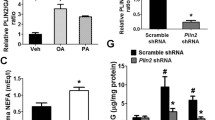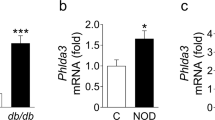Abstract
SUMOylation has long been recognized to regulate multiple biological processes in pancreatic beta cells, but its impact on proinsulin disulfide maturation and endoplasmic reticulum (ER) stress remains elusive. Herein, we conducted comparative proteomic analyses of SUMOylated proteins in primary mouse/human islets following proinflammatory cytokine stimulation. Cytokine challenge rendered beta cells to undergo a SUMOylation turnover manifested by the changes of SUMOylation substrates and SUMOylation levels for multiple substrates. Our data support that SUMOylation may play a crucial role to regulate proinsulin misfolding and ER stress at least by targeting Protein Disulfide Isomerase a3 (Pdia3). SUMOylation regulates Pdia3 enzymatic activity, subcellular localization, and protein binding ability. Furthermore, SUMOylation of Pdia3 exacerbated proinsulin misfolding and ER stress, and repressed Stat3 activation. In contrast, disruption of Pdia3 SUMOylation markedly rescued the outcomes. Collectively, our study expands the understanding how SUMOylation regulates ER stress in beta cells, which shed light on developing potential strategies against beta cell dysfunction.





Similar content being viewed by others
Data availability
All data needed to evaluate the conclusion in the paper are present in the paper and/or the electronic supplementary material. Additional data related to this paper may be requested from the authors.
Abbreviations
- C:
-
cysteine
- Co-IP:
-
co-immunoprecipitation
- CRP:
-
C-reactive protein
- DTT:
-
dithiothreitol
- ECAR:
-
extracellular acidification rate
- GSIS:
-
glucose-stimulated insulin secretion
- K:
-
lysine
- MU:
-
mutant
- OCR:
-
oxygen consumption rate
- PDI:
-
protein disulfide isomerase
- PTM:
-
post-translational modification
- R:
-
arginine
- RLU:
-
relative luciferase
- SUMO:
-
small ubiquitin like modifier
- Thap:
-
thapsigargin
- UBC9:
-
SUMO-conjugating enzyme 2
References
Zhao J (2007) Sumoylation regulates diverse biological processes. Cell Mol Life Sci 64:3017–3033
Shao C, Cobb MH (2009) Sumoylation regulates the transcriptional activity of MafA in pancreatic beta cells. J Biol Chem 284:3117–3124
Dai XQ, Kolic J, Marchi P, Sipione S, Macdonald PE (2009) SUMOylation regulates Kv2.1 and modulates pancreatic beta-cell excitability. J Cell Sci 122:775–779
He X, Lai Q, Chen C, Li N, Sun F, Huang W, Zhang S, Yu Q, Yang P, Xiong F, Chen Z, Gong Q, Ren B, Weng J, Eizirik DL, Zhou Z, Wang CY (2018) Both conditional ablation and overexpression of E2 SUMO-conjugating enzyme (UBC9) in mouse pancreatic beta cells result in impaired beta cell function. Diabetologia 61:881–895
Dai XQ, Plummer G, Casimir M, Kang Y, Hajmrle C, Gaisano HY, Manning Fox JE, MacDonald PE (2011) SUMOylation regulates insulin exocytosis downstream of secretory granule docking in rodents and humans. Diabetes 60:838–847
Rajpal G, Schuiki I, Liu M, Volchuk A, Arvan P (2012) Action of protein disulfide isomerase on proinsulin exit from endoplasmic reticulum of pancreatic beta-cells. J Biol Chem 287:43–47
Hodish I, Liu M, Rajpal G, Larkin D, Holz RW, Adams A, Liu L, Arvan P (2010) Misfolded proinsulin affects bystander proinsulin in neonatal diabetes. J Biol Chem 285:685–694
He K, Cunningham CN, Manickam N, Liu M, Arvan P, Tsai B (2015) PDI reductase acts on Akita mutant proinsulin to initiate retrotranslocation along the Hrd1/Sel1L-p97 axis. Mol Biol Cell 26:3413–3423
Cunningham CN, He K, Arunagiri A, Paton AW, Paton JC, Arvan P, Tsai B (2017) Chaperone-driven degradation of a misfolded proinsulin mutant in parallel with restoration of wild-type insulin secretion. Diabetes 66:741–753
Tersey SA, Nishiki Y, Templin AT, Cabrera SM, Stull ND, Colvin SC, Evans-Molina C, Rickus JL, Maier B, Mirmira RG (2012) Islet beta-cell endoplasmic reticulum stress precedes the onset of type 1 diabetes in the nonobese diabetic mouse model. Diabetes 61:818–827
Turano C, Coppari S, Altieri F, Ferraro A (2002) Proteins of the PDI family: unpredicted non-ER locations and functions. J Cell Physiol 193:154–163
Ruddock LW (2006) Gaining access to ERp57 function. Structure 14:1209–1210
Kozlov G, Maattanen P, Schrag JD, Pollock S, Cygler M, Nagar B, Thomas DY, Gehring K (2006) Crystal structure of the bb’ domains of the protein disulfide isomerase ERp57. Structure 14:1331–1339
Dong G, Wearsch PA, Peaper DR, Cresswell P, Reinisch KM (2009) Insights into MHC class I peptide loading from the structure of the tapasin-ERp57 thiol oxidoreductase heterodimer. Immunity 30:21–32
Kang SJ, Cresswell P (2002) Calnexin, calreticulin, and ERp57 cooperate in disulfide bond formation in human CD1d heavy chain. J Biol Chem 277:44838–44844
Qi M, Barbaro B, Wang S, Wang Y, Hansen M, Oberholzer J (2009) Human pancreatic islet isolation: part I: digestion and collection of pancreatic tissue. J Vis Exp.
Wang F, Sun F, Luo J, Yue T, Chen L, Zhou H, Zhang J, Yang C, Luo X, Zhou Q, Zhu H, Li J, Yang P, Xiong F, Yu Q, Zhang H, Zhang W, Xu A, Zhou Z, Lu Q, Eizirik DL, Zhang S, Wang CY (2019) Loss of ubiquitin-conjugating enzyme E2 (Ubc9) in macrophages exacerbates multiple low-dose streptozotocin-induced diabetes by attenuating M2 macrophage polarization. Cell Death Dis 10:892
Cheng J, Song J, He X, Zhang M, Hu S, Zhang S, Yu Q, Yang P, Xiong F, Wang DW, Zhou J, Ning Q, Chen Z, Eizirik DL, Zhou Z, Zhao C, Wang CY (2016) Loss of Mbd2 protects mice against high-fat diet-induced obesity and insulin resistance by regulating the homeostasis of energy storage and expenditure. Diabetes 65:3384–3395
Rutter GA, Hodson DJ, Chabosseau P, Haythorne E, Pullen TJ, Leclerc I (2017) Local and regional control of calcium dynamics in the pancreatic islet. Diabetes Obes Metab 19(Suppl 1):30–41
Arunagiri A, Haataja L, Cunningham CN, Shrestha N, Tsai B, Qi L, Liu M, Arvan P (2018) Misfolded proinsulin in the endoplasmic reticulum during development of beta cell failure in diabetes. Ann N Y Acad Sci 1418:5–19
Ramirez-Rangel I, Bracho-Valdes I, Vazquez-Macias A, Carretero-Ortega J, Reyes-Cruz G, Vazquez-Prado J (2011) Regulation of mTORC1 complex assembly and signaling by GRp58/ERp57. Mol Cell Biol 31:1657–1671
Coe H, Jung J, Groenendyk J, Prins D, Michalak M (2010) ERp57 modulates STAT3 signaling from the lumen of the endoplasmic reticulum. J Biol Chem 285:6725–6738
Turkson J, Bowman T, Garcia R, Caldenhoven E, De Groot RP, Jove R (1998) Stat3 activation by Src induces specific gene regulation and is required for cell transformation. Mol Cell Biol 18:2545–2552
Bachar-Wikstrom E, Wikstrom JD, Ariav Y, Tirosh B, Kaiser N, Cerasi E, Leibowitz G (2013) Stimulation of autophagy improves endoplasmic reticulum stress-induced diabetes. Diabetes 62:1227–1237
Haissaguerre M, Saucisse N, Cota D (2014) Influence of mTOR in energy and metabolic homeostasis. Mol Cell Endocrinol 397:67–77
Manning Fox JE, Hajmrle C, Macdonald PE (2012) Novel roles of SUMO in pancreatic beta-cells: thinking outside the nucleus. Can J Physiol Pharmacol 90:765–770
Vergari E, Plummer G, Dai X, MacDonald PE (2012) DeSUMOylation controls insulin exocytosis in response to metabolic signals. Biomolecules 2:269–281
Donath MY, Dinarello CA, Mandrup-Poulsen T (2019) Targeting innate immune mediators in type 1 and type 2 diabetes. Nat Rev Immunol 19:734–746
Spoden GA, Morandell D, Ehehalt D, Fiedler M, Jansen-Durr P, Hermann M, Zwerschke W (2009) The SUMO-E3 ligase PIAS3 targets pyruvate kinase M2. J Cell Biochem 107:293–302
Ritterhoff T, Das H, Hofhaus G, Schroder RR, Flotho A, Melchior F (2016) The RanBP2/RanGAP1*SUMO1/Ubc9 SUMO E3 ligase is a disassembly machine for Crm1-dependent nuclear export complexes. Nat Commun 7:11482
Jang I, Pottekat A, Poothong J, Yong J, Lagunas-Acosta J, Charbono A, Chen Z, Scheuner DL, Liu M, Itkin-Ansari P, Arvan P, Kaufman RJ (2019) PDIA1/P4HB is required for efficient proinsulin maturation and ss cell health in response to diet induced obesity. Elife 8:e44528
Yang P, Li M, Guo D, Gong F, Adam BL, Atkinson MA, Wang CY (2008) Comparative analysis of the islet proteome between NOD/Lt and ALR/Lt mice. Ann N Y Acad Sci 1150:68–71
Gorasia DG, Dudek NL, Safavi-Hemami H, Perez RA, Schittenhelm RB, Saunders PM, Wee S, Mangum JE, Hubbard MJ, Purcell AW (2016) A prominent role of PDIA6 in processing of misfolded proinsulin. Biochim Biophys Acta 1864:715–723
Woehlbier U, Colombo A, Saaranen MJ, Perez V, Ojeda J, Bustos FJ, Andreu CI, Torres M, Valenzuela V, Medinas DB et al (2016) ALS-linked protein disulfide isomerase variants cause motor dysfunction. EMBO J 35:845–865
Wang H, Chan PK, Pan SY, Kwon KH, Ye Y, Chu JH, Fong WF, Tsui WM, Yu ZL (2010) ERp57 is up-regulated in free fatty acids-induced steatotic L-02 cells and human nonalcoholic fatty livers. J Cell Biochem 110:1447–1456
Hoffman SM, Tully JE, Nolin JD, Lahue KG, Goldman DH, Daphtary N, Aliyeva M, Irvin CG, Dixon AE, Poynter ME, Anathy V (2013) Endoplasmic reticulum stress mediates house dust mite-induced airway epithelial apoptosis and fibrosis. Respir Res 14:141
Li Y, Camacho P (2004) Ca2+−dependent redox modulation of SERCA 2b by ERp57. J Cell Biol 164:35–46
Kang S, Dahl R, Hsieh W, Shin A, Zsebo KM, Buettner C, Hajjar RJ, Lebeche D (2016) Small molecular allosteric activator of the sarco/endoplasmic reticulum Ca2+-ATPase (SERCA) attenuates diabetes and metabolic disorders. J Biol Chem 291:5185–5198
Acknowledgments
We sincerely thank Dr. Jinxiu Li (Shenzhen Third People’s Hospital, Shenzhen, Guangdong, China) for discussing and reviewing the manuscript.
Code availability
Not applicable.
Funding
This study was supported by the Ministry of Science and Technology of China (2016YFC1305002 and 2017YFC1309603), the National Natural Science Foundation of China (81471046, 81530024, 91749207, 81920108009, 81770823 and 81670729), NHC Drug Discovery Program of China (2017ZX09304022–07), the Department of Science and Technology of Hubei Province (2017ACA096), the Integrated Innovative Team for Major Human Disease Programs of Tongji Medical College, Huazhong University of Science and Technology, and the Innovative Funding for Translational Research from Tongji Hospital.
Author information
Authors and Affiliations
Contributions
N.L. and X.L. were responsible for conducting all experiments, data analysis, and writing the manuscript. F.X., Q.Y., and P.Y. were responsible for conducting all experiments and data analysis. N.L., S.Z., and C.-Y.W. were involved in all method establishment and modification. X.W., J.J., and J.X. were responsible for collecting human pancreas. N.L. and C.-Y.W were responsible for writing the manuscript. S.Z. and Q.G. contributed to discuss and review the manuscript. N.L. and C.-Y.W. were responsible for funding acquisition. D.L E., Z.Z., J.Z., and S.Z. contributed to the review of the manuscript and manuscript preparation. C.-Y.W. is the guarantor of this work and had full access to all the data in the study and takes responsibility for the integrity of the data and the accuracy of the data analysis.
Corresponding authors
Ethics declarations
Conflict of interest
The authors declare that they have no conflict of interest.
Additional information
Publisher’s note
Springer Nature remains neutral with regard to jurisdictional claims in published maps and institutional affiliations.
Rights and permissions
About this article
Cite this article
Li, N., Luo, X., Yu, Q. et al. SUMOylation of Pdia3 exacerbates proinsulin misfolding and ER stress in pancreatic beta cells. J Mol Med 98, 1795–1807 (2020). https://doi.org/10.1007/s00109-020-02006-6
Received:
Revised:
Accepted:
Published:
Issue Date:
DOI: https://doi.org/10.1007/s00109-020-02006-6




